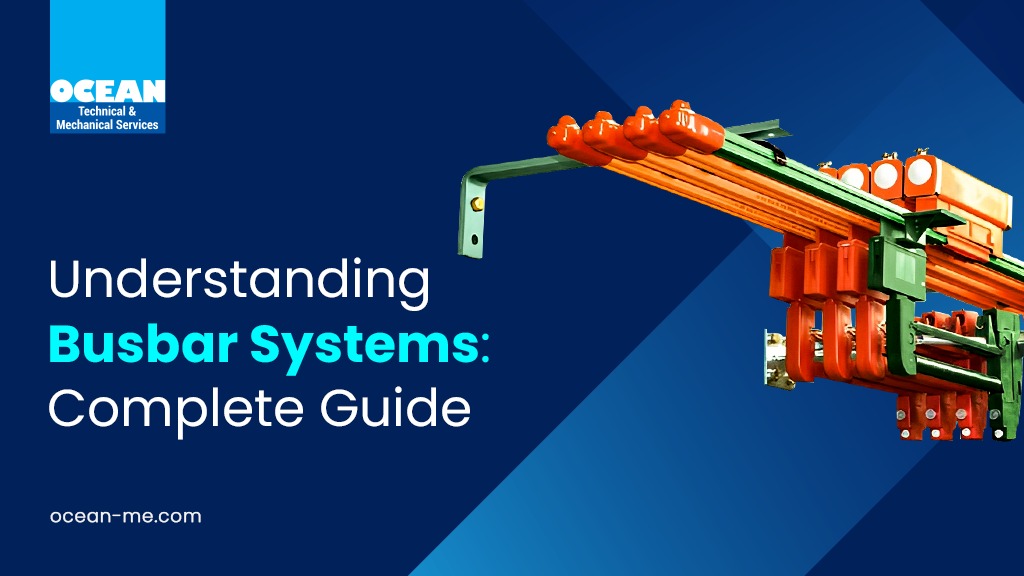Cranes play a significant role in many industries, ranging from construction to logistics. They help in the safe and efficient movement of heavy loads and objects. These mechanical marvels require a lot of power to operate efficiently. The lifeline of crane power distribution systems, although of great importance, goes unnoticed most times. In this article, we delve deeper into the busbar systems and explore how they contribute to powering cranes efficiently and safely.
You may also like to read:
- Oil Analysis In The Marine Industry By Ocean
- Turbo Machinery Analysis and Balancing
- Crane Rail Installation- Standards, Procedures, and Services from Ocean
The Crucial Role of Busbar Systems in Crane Operations
Cranes are best known for their capability to precisely move, lift, and lower massive objects. However, these tasks necessitate a substantial amount of electric power. The power required by cranes to operate safely and efficiently is provided by the busbar systems.
The word busbar is derived from the Latin word ‘omnibus’ which, in simple terms, means for all; and carries all of the power. Made of metal bars (typically copper or aluminium), they are used to supply power and are mounted in the crane’s cabinet.
There are different types of crane busbars that cater to various crane applications, such as multistage pipe safety busbars, enclosed busbars, insulated conductor systems, cable crane busbars, integrated crane busbars, unipolar pairing busbars, etc. Among these, the open or insulated busbar, which is a horizontal metal conductor, is used as a power system for overhead cranes.
Busbar systems can be used for both indoor and outdoor cranes and are designed to withstand the harsh conditions, in which cranes routinely work while transporting large currents. When operating, the busbar system distributes the required electricity power to various parts of the crane, including motors, hoists, and winches, so that they can function safely and efficiently. Cranes wouldn’t work effectively without busbar systems.
The following are some particular advantages of busbar systems in crane operations:
- Offer a reliable way to dispense power to the various components of a crane, like motors, hoists, and winches.
- They are easy to maintain, repair and are able to withstand the harsh environments that cranes often operate in.
- An EOT (Electric Overhead Travelling) crane can be modified to meet the particular needs of use.
Challenges of Traditional Cable Systems in Cranes
If you need a reliable and efficient way to power your crane, a busbar system can be the best option. For the distribution of electricity, cranes usually use old, conventional cable networks, which frequently have a number of challenges, including wear and tear, maintenance problems, safety threats, and more. The lack of such problems helps busbar systems be more reliable and effective. Moreover, there is less chance of vibration or corrosion impairing the busbar systems.
The main components of crane busbar systems are:
- Main conductor bars: These bars are strategically placed along the crane’s path and serve as the primary channel for distributing power to crane hoists and trolleys.
- Collector shoes: The collector shoes slide along the conductor bars when the crane moves and establish a consistent and stable power supply.
- Insulating covers: These covers protect the conductor bars from environmental factors such as dust, moisture, and other destructive elements.
- Expansion joints: These joints prevent structural damage caused by thermal expansion and contraction of the conductor system.
Safety Considerations in Busbar Systems for Cranes
Busbar systems are a great choice for several applications, including industrial, manufacturing, and construction. They are used in different crane operations to guarantee efficient power distribution and safety. Overhead cranes are used for heavy lifting in commercial settings; port cranes load and unload ships; bridge cranes lift heavy objects and move them longitudinally; gantry cranes move materials in construction sites and shipyards; and jib cranes used in confined spaces are some of the most common applications.
Operating busbar systems necessitates careful attention to safety. Proper grounding, in-line access to emergency shutdown systems, insulation lining to protect against environmental hazards, training, and awareness among operators and other personnel are all crucial factors that cannot be overlooked.
Read more about:
- Pinch Valve Mechanism – How They Work
- Benefits and Importance of Preventive Maintenance
- Crane Load Testing: Ensuring Safe and Reliable Crane Operations
Inspection and Maintenance of Busbar Systems in Cranes
Routine inspection and maintenance are prerequisites for ensuring the longevity and smooth functioning of busbar systems. Below are a few key tasks to be followed:
- Visual inspections: Reparations due to wear and tear or corrosion can be identified by regular inspection.
- Cleaning and maintenance: Ground collector shoes used to provide analogous ground must be kept clean and well-maintained for better electrical contact.
- Infrared thermography: This can be used to detect likely hotspots that may indicate electrical issues.
- Scheduled maintenance: This not only averts unexpected downtime but also helps extend the longevity of the busbar system.
Future Trends in Busbar Systems for Crane Applications
The busbar systems for cranes are taking the leap to meet the latest and increasing demands of the industry. With the advent of newer technologies, they are keen on integrating state-of-the-art technology for smart monitoring, which can augment reliability and assist in subsiding downtime and maintenance. Also, adding energy-efficient, high-conductivity materials and eco-friendly designs would focus on sustainability and contribute to a greener future.
Final Wrap
Busbar systems are essential in ensuring safe and efficient crane operations. These systems provide a reliable and adaptable method for distributing power, reducing outages, and enhancing security. As technology advances, busbar systems have a bright future ahead of them, with even more innovative crane application options. If you work in an industry where crane operations are crucial, try taking the advantages of busbar systems into consideration as a smart first step towards enhancing efficiency and safety.



